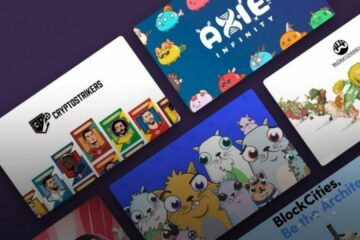The non-fungible token (NFT) gained importance in 2020. It caught the attention of the mainstream media and increased interest not only from blockchain technology enthusiasts, but also from investors and consumers.
NFT stands for non-fungible tokens. NFTs offer content creators a new level of control over their work, especially in the field of digital art and collectibles. As a valuable asset, NFTs can also be used in decentralized finance (DeFi) and thus bring two aspects of the blockchain ecosystem together.
In this article you will find everything you need to know about NFTs: the explanation of the term, how the cryptocurrency technology works, the buying / selling possibilities of the token and the risks involved.
What are NFT tokens?
What is an NFT? Put simply, it is a type of cryptocurrency token that is generated on the Ethereum blockchain in a smart contract. The concept originated in 2015. The first NFT projects were started in 2017 in the ERC 20 standard, further standards followed two years later.
NFTs are now being developed on the ERC-721 protocol on the Ethereum blockchain as ERC-721 tokens are unique while ERC-20 tokens are identical.
How do NFTs work?
NFTs differ from cryptocurrencies like Bitcoin (BTC), Ether (ETH) or Cardano (ADA), which act as digital coins. NFTs are tokens that represent digital or physical assets, e.g. B. a work of art, music or possibly even a property, and contain additional information that a coin would not carry. NFTs can be used to authenticate works of art and other collectibles.
What does NFT mean? A token is a unit of currency. A non-fungible token is a token that cannot be exchanged for anything else. For example, a banknote is fungible because it can be exchanged for other banknotes of the same value. However, a plane ticket is not fungible because it contains unique information and cannot be used in place of another passenger’s ticket. In the same way, NFT is a unique token that can be used to distribute and verify ownership over the blockchain.
How are NFTs used?
Where are NFTs used? NFTs are used as a means of selling exclusive items online. Potentially, they can be used to verify anything relevant to proof of ownership, including:
Even tweets can be sold as NFTs. For example, Twitter co-founder Jack Dorsey auctioned his first tweet for millions of dollars in March 2021, converted the proceeds into bitcoin, and donated them to charity. Digital articles can be unique. But other objects, of which there are several copies, can be valuable because they have a value for collectors, e.g. B. Sports exchange cards.
What NFT tokens are there?
High profile NFT sales and projects launched by celebrities and well-known brands have shown the uses of the technology. Here are some recent examples:
In July 2020, actor William Shatner sold 10,000 packages of memorabilia with a total of 125,000 digital photo NFTs on the World Asset eXchange (WAX Blockchain) in just nine minutes. The NFT format allows users to buy and sell the trading cards knowing that they are certified as authentic and contain full trading history and owner details. The packages contained broken pieces that could be combined to create new collectibles. In addition, 25 cards could be redeemed for a signed portrait and one card for a signed action figure.
Sportswear company Nike patented an NFT project in December 2019, a system called CryptoKicks, which it intends to use to issue NFTs on shoes. CryptoKick tokens should be used to link physical shoes to digital versions with a number of uses, including verifying their authenticity, trading on digital marketplaces, using them in video games and other virtual environments, and notifying customers when virtual shoe models are on getting produced. The digital shoes could change their appearance and value due to changes in the physical shoes such as footwear. B. Age and usage change, which would affect their value.
What Are the Most Expensive NFTs Ever Sold? In February 2021, Crossroads, an animation by digital artist Mike Winkelmann known as Beeple, sold for $ 6.6 million on an NFT platform called Nifty Gateway. That far exceeded the previous record for a single NFT of $ 1.55 million, and was 100 times the $ 66,666.60 for which the plant was originally sold in November 2020.
A similar price, $ 6 million, went to music artist Grimes following an NFT artwork auction in February 2021. She sold 10 works on Nifty Gateway in less than 20 minutes. The WarNymph Collection includes videos, pictures and music. A one-off, 50-second video sold for $ 389,000, while 700 copies of two videos sold for $ 7,500 each.
The auction for the world’s first tokenized album also took place in February. In less than 24 hours, 3LAU, a famous American electronic music producer, sold 33 unique NFTs for a total of $ 11.7 million.
NFTs and DeFi
NFTs have great potential for use in the rapidly evolving world of decentralized finance (DeFi). You can e.g. They can be used, for example, to deposit art, real estate or other assets as collateral for loans, or as financial contracts for insurance, stock options or bonds that are traded as products in secondary markets. They can also be used as governance tokens for NFT marketplaces. NFTs have been around for a number of years, but DeFi’s growth is likely what makes them more attractive as digital assets with a range of uses.
Why are NFTs important?
How is the hype surrounding NFTs to be explained? As a digital record of real value, NFTs can be used to maintain and exchange ownership of physical assets in a digital marketplace. That has the potential to fuel the NFT revolution in buying and selling rare and valuable items.
What’s the point of NFTs?
When an NFT is “coined” and the associated content is uploaded, the owner has evidence that he is the sole holder of the token, which affords the scarcity of the asset.
The introduction of NFTs could completely transform the music industry as it struggles with content monetization in the age of streaming and declining physical sales. Companies like the digital rights management platform RAIR see the potential for musicians to use NFTs to license and distribute their own content. Using smart contracts on the blockchain would allow artists to earn royalties every time their work is resold. It should be noted that transferring ownership of an NFT does not transfer any trademark or copyright to the holder. And the author can upload multiple versions of a work, each with their own NFTs, so it doesn’t have to be just one-of-a-kind to be distributed that way.
There is also great potential for NFTs to be used in gaming, where they would form the foundation for the virtual economy. Players could use NFTs to claim possession of rare or hard-to-get items, as rewards for completing challenges, or attending special events, to convert points into currencies for real-world money transfers.
Content creators could use NFTs to monetize their work directly from players
NFTs are attractive to investors because, like any other asset, they can be bought at a profit in an NFT market and sold as their value increases.
Institutional funds are taking the opportunity with the help of cryptocurrency investment firms buying digital collectibles to create value for their clients. NFTs are just beginning to develop and there is great potential for growth across the digital economy. Their popularity exploded in late 2020 when cryptocurrencies made new highs.



0 Comments